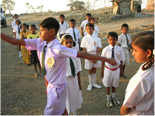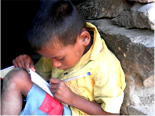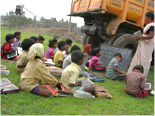|
|||||||||||||||||||
|
|||||||||||||||||||

Innovative Education for Stone Quarry Children
 Santulan’s Pashan Shala is an innovative educational program evolved by Santulan to promote appropriate education. Pashan Shala provides the right to education for the hard to reach category of children and child labourers in the stone quarry sector. In 1997 the first school began with 119 children in Pune. It gradually expended to neighboring districts in Pune, Nasik, Aurangabad and Amravati divisions covering 20 districts and promoting education among 29,036 children across the State of Maharashtra.
For the year 2010-11 there were 36 Bal Pashan Shalas for the 3 to 5 age group with 701 children and 126 Pashan Shalas for the 6 to 14 age group with 2826 children studying in 1st to 8th grade. The Pashan Shalas covered the districts of Pune, Nagar, Kolhapur, Satara, Sangali, Nasik, Beed, Nanded, Parbhani, Latur, Usmanabad, Hingloi, Solapur, Jalgaon, Dhule and Yewatmal.
Santulan’s Pashan Shala is an innovative educational program evolved by Santulan to promote appropriate education. Pashan Shala provides the right to education for the hard to reach category of children and child labourers in the stone quarry sector. In 1997 the first school began with 119 children in Pune. It gradually expended to neighboring districts in Pune, Nasik, Aurangabad and Amravati divisions covering 20 districts and promoting education among 29,036 children across the State of Maharashtra.
For the year 2010-11 there were 36 Bal Pashan Shalas for the 3 to 5 age group with 701 children and 126 Pashan Shalas for the 6 to 14 age group with 2826 children studying in 1st to 8th grade. The Pashan Shalas covered the districts of Pune, Nagar, Kolhapur, Satara, Sangali, Nasik, Beed, Nanded, Parbhani, Latur, Usmanabad, Hingloi, Solapur, Jalgaon, Dhule and Yewatmal.
Gender Ratio of Children
It’s much more than merely access to education. The education has to be appropriate and accommodative of children’s difficulties, especially in ‘hand to mouth’ families where female children have to assist with the house work from childhood. Santulan’s educational programme has exclusively emerged out of the needs of the children.
| Sex | No. of Children in Innovative Education |
| Male | 1837 |
| Female | 1713 |
| Total | 3550 |
Caste Ratio of Children
 With the growing displacement from their sources of livelihood, various socio-economically marginalized communities are found ‘toiling for survival’ in the stone quarry sector. At any point of the year the caste ratio of children in Pashan Shalas has significantly been as much as 93% belonging to de-notified and nomadic tribes and Dalits, Adivasis and OBCs.
With the growing displacement from their sources of livelihood, various socio-economically marginalized communities are found ‘toiling for survival’ in the stone quarry sector. At any point of the year the caste ratio of children in Pashan Shalas has significantly been as much as 93% belonging to de-notified and nomadic tribes and Dalits, Adivasis and OBCs.The most predominant group of communities engaged in the stone quarry sector is Vimukta Jaties, Nomadic Tribes. They are politically ‘quiet’ and are not seen as constituting a decisive vote bank due to their migrant nature. It is apparent that there is a lot of apathy amongst the policy makers and planners about these communities. For many of them these communities are inconsequential. Many are not even aware of their existence. The second large group engaged in the stone quarry sector belong to Scheduled Caste, Scheduled Tribes and Other Backwards Communities.
 It’s another strange phenomenon that communities who run the village industries, like for example; artisans, tailors, shoe makers, fishermen, carpenters, potters, shepherds, iron smiths, gardeners, dyers and weavers, washer men, barbers, milkmen, collectors of forest produce and so on are found in the stone quarrying sector. These historically disadvantaged communities were accorded certain privileges to overcome their socio-economic disabilities after independence. Unfortunately, whatever efforts the government puts in through various welfare commissions, these communities still remain isolated, ignored and wanderers, surviving without existence.
It’s another strange phenomenon that communities who run the village industries, like for example; artisans, tailors, shoe makers, fishermen, carpenters, potters, shepherds, iron smiths, gardeners, dyers and weavers, washer men, barbers, milkmen, collectors of forest produce and so on are found in the stone quarrying sector. These historically disadvantaged communities were accorded certain privileges to overcome their socio-economic disabilities after independence. Unfortunately, whatever efforts the government puts in through various welfare commissions, these communities still remain isolated, ignored and wanderers, surviving without existence.The third category of workers in the stone quarry sector are from the open class and belong to majority and minority communities of Muslims, Christian and others. They constitute significantly over 13% of the total work force in the quarry sector.
| Caste Category | 2010-11 | Percentage |
| S.C. | 826 | 23% |
| S.T. | 382 | 11% |
| V.J. | 1626 | 46% |
| N.T. | 291 | 8% |
| O.B.C | 95 | 3% |
| Open | 330 | 9% |
| Total | 3550 | 100% |
| © 2012 Santulan. All rights reserved. | Powered By |
